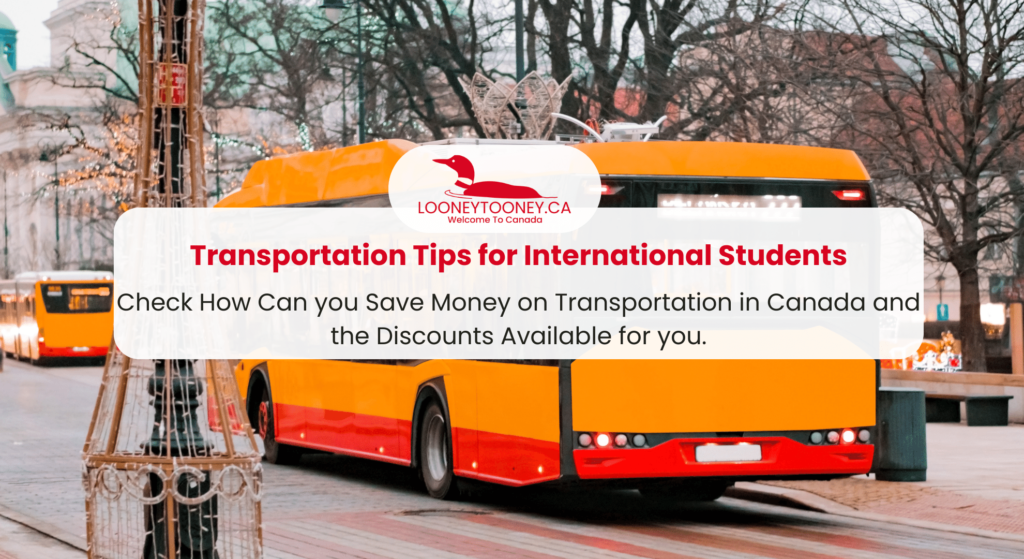Canada is an attractive destination for international students, offering top-notch education and a multicultural environment. However, one aspect that students, particularly newcomers, need to navigate is transportation. Canada is a vast country with diverse transportation options, and understanding how to get around efficiently and cost-effectively can significantly enhance your student experience. In this article, we’ll provide transportation tips specifically tailored to international students to help you save money, travel safely, and make the most of your time in Canada.
What Are the Type of Public Transportation Available in Canada?
Public transportation is a lifeline for many international students in Canada, offering a cost-effective and efficient way to get around cities and campuses. Whether you’re studying in bustling metropolitan cities like Toronto, and Vancouver, or more relaxed settings in smaller towns, understanding how to utilize public transit can help you save money, navigate your new surroundings, and make the most of your student experience.
The following are the different types of transportation available in Canada.
1. Buses
Extensive bus services are readily accessible throughout the country, catering to both urban commuting and intercity travel. Municipal transit authorities typically manage local bus networks, ensuring frequent routes and dependable timetables.
2. Subway and Light Rail Systems
Major urban centers like Toronto, Montreal, and Vancouver boast efficient subway and light rail systems, delivering swift and cost-effective transit solutions. These systems provide extensive coverage, seamlessly connecting vital city districts.
3. Trains
Canada’s comprehensive train network offers convenient transportation options for both regional and national travel. Via Rail, the nation’s primary passenger rail service, presents various choices, including student discounts and passes, for those seeking longer-distance journeys.
4. Ferries
Coastal regions in Canada offer ferry services, linking diverse islands and presenting picturesque transportation opportunities. These ferry services are especially valuable for exploring coastal regions and nearby islands, delivering memorable travel experiences.
Utilizing public transit is not only cost-effective but also environmentally friendly. As an international student in Canada, it’s a valuable resource that allows you to explore your new surroundings, attend classes, and access various amenities conveniently. By understanding your local transit options, taking advantage of student discounts, and planning your routes, you can navigate your student life with ease while saving money for other exciting experiences during your stay in Canada.
How Can I Save Money on Transportation in Canada?
Campus Shuttle Services
Many universities and colleges operate free or low-cost campus shuttle services. These shuttles provide convenient transportation between different campus buildings, facilities, and parking lots. International students in Canada have access to various campus shuttle services for convenient transportation between campuses and other essential locations.
Consider a Bike: A Sustainable Transportation Option for International Students
When it comes to getting around as an international student in Canada, one often-overlooked and highly beneficial mode of transportation is the bicycle. Bicycles offer a range of advantages, including affordability, sustainability, and flexibility, making them an excellent choice for students looking to navigate Canadian cities and campuses efficiently. Here’s a detailed look at why you should consider a bike as your mode of transportation:
How can I use bikes in Ontario for commuting?
- Bicycles in Ontario start at a reasonable price of CA$175 and offer a cost-effective and time-saving mode of transportation.
- Cycling is gaining popularity in numerous Ontario cities, thanks to the presence of dedicated bike lanes and trails that ensure safe and convenient bike travel.
- Additionally, several universities and colleges offer budget-friendly bike-sharing initiatives, allowing students to easily rent bicycles for brief periods. These initiatives are both economical and adaptable, particularly for students requiring occasional bike transportation.
- Ontario also offers e-bikes as an option for commuting, providing an efficient and eco-friendly way to get around.
How can I use bikes in British Columbia for commuting?
- British Columbia, particularly cities like Vancouver, is known for its robust cycling culture with an extensive network of bike lanes and trails.
- Many universities and colleges in British Columbia offer affordable bike-sharing programs, allowing students to rent bicycles conveniently.
How can I use bikes in Alberta for commuting?
- Alberta, especially during the summer months, is a popular destination for cyclists.
- Cities like Calgary boast comprehensive bike paths and trails, providing excellent cycling opportunities.
- Several universities and colleges in Alberta also provide bike-sharing programs for students.
What are Flat Tire Bikes used in Winters?
- Flat tire bikes are an excellent choice for winter travel, ensuring students can bike year-round, even in snowy conditions.
- It’s a favored transit method among students for its cost-efficiency and time-saving benefits.
Choosing a bicycle as your mode of transportation as an international student in Canada offers numerous advantages. It’s a budget-friendly, eco-conscious, and healthy way to get around while providing you with the flexibility to explore your new surroundings. Whether you’re commuting to classes, exploring your city, or simply enjoying the freedom of two wheels, biking can greatly enhance your student experience in Canada.
Carpooling and Ridesharing: Efficient and Cost-Effective Transportation Options for International Students
Carpooling and ridesharing are increasingly popular and convenient transportation choices for international students in Canada. Carpooling and ridesharing are highly efficient and cost-effective transportation choices for international students in Canada.
These options offer not only financial benefits but also the chance to reduce your environmental footprint and build valuable social connections. Whether you’re commuting to classes, exploring your new city, or simply enjoying the convenience of sharing rides, carpooling and ridesharing can significantly enhance your student experience in Canada.
What Discounts are Available in Public Transport for International Students in Canada?
One of the key advantages of being an international student in Canada is the access to a variety of transportation discounts and passes tailored to your needs. These discounts can significantly alleviate the financial burden of commuting and make exploring your new home more affordable. In this detailed guide, we’ll explore how you can leverage student discounts on transportation to enhance your mobility and save money during your studies in Canada:
1. International Student Identity Card (ISIC)
The International Student Identity Card (ISIC) is a powerful tool that can significantly enhance the experience of international students studying in Canada. Recognized worldwide, the ISIC is not just an identification card; it’s a gateway to a wide range of discounts, benefits, and services tailored to the needs of students.
2. Monthly or Semester Passes
One of the most common types of student discounts is the availability of monthly or semester transit passes. These passes provide unlimited travel within a specified period for a fixed fee, making them particularly cost-effective for regular commuters.
3. Single-Trip Discounts
In addition to passes, some cities offer reduced fares for individual trips, typically during off-peak hours. This can be advantageous for occasional travelers or students with flexible schedules.
4. Regional Discounts
In larger metropolitan areas, regional transportation authorities may provide integrated transit systems that allow you to use multiple modes of transportation (e.g., buses and subways) with a single fare, further optimizing your commute.
How to Avail Student Discounts on Transportation in Canada?
1. Check Local Eligibility
It’s essential to familiarize yourself with the specific eligibility criteria for student discounts in your city or region. Some areas may require you to be enrolled full-time, while others extend these benefits to part-time students as well.
2. Student Identification
Ensure you have a valid student ID card issued by your educational institution. Some transit authorities may also provide specialized student transit cards that you’ll need to obtain.
3. Online Registration
In many cases, you’ll need to register online or visit a local transit office to apply for student discounts. Provide the required documentation, including proof of student status, to complete the registration process.
You can visit the official websites of local transit authorities or transportation departments to learn about the student discount programs available in your area.
Also, educational institutions often provide information and resources related to student transportation discounts. Reach out to your school’s international student services or campus transportation office for guidance. Also check our article Exploring the Best Neighborhoods in Mississauga, Ontario.
Other Ways to Save Cost on Transportation
Selecting the right accommodation is a critical aspect of your journey as an international student in Canada. Where you live not only impacts your daily life but also influences your overall well-being and academic success. To make the most of your experience, it’s essential to plan your accommodation strategically. In this detailed guide, we’ll explore how to choose and plan your accommodation wisely. You can also check our article Comparing the Cost of Living for Students Across Various Canadian Cities
- Consider Location: When searching for accommodation, prioritize options that are close to your educational institution. Proximity to campus can save you valuable commuting time and transportation expenses.
- Accessibility: Check the accessibility of your chosen accommodation, especially if you plan to use public transit or bike to campus. Ensure that it’s well-connected to transportation options.
By exploring and utilizing student transportation services, you can streamline your daily commute, reduce transportation expenses, and contribute to sustainable commuting practices. These services are designed to cater to the unique needs of students, ensuring that you have convenient and efficient transportation options during your studies in Canada.





